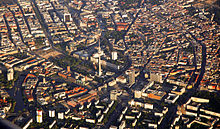Settlement (urban development)

The term settlement describes in the urban planning sense a coherent and coordinated grouping of buildings according to a designed plan . These are primarily planned urban expansions on the outskirts and newly created suburbs in the outskirts of a city, many of which have emerged since the late 19th century as cities grew through industrialization . The buildings form a unit as an ensemble .
Older settlements are today in many places under ensemble protection as a complete complex . Settlements are usually districts of previously existing localities. Often - but not necessarily - they are residential areas in open construction . The formative development can have very different characters: housing developments , row houses or high-rise buildings are common development variants. In particular, large housing estates and social housing estates from the post-war period have been criticized for decades.
development
Origins and development until 1945
The rapid growth of cities as a result of immigration from rural areas and the increasing number of births during industrialization in the 19th century led to poor housing conditions in many places. The densely built-up and sometimes clearly overcrowded Berlin tenements with their narrow courtyards , often barely lit with daylight, were considered a negative example.
On the other hand, in the 19th century, so-called villa colonies emerged as newly laid out city districts in front of the core city or as separate local foundations. As a rule, however, they were not yet referred to as settlements, but rather as colonies . But there were also so-called workers' settlements back then . They have been since the late 19th century in part to the ideals of the garden city - movement built. A particular example of this is the Margarethenhöhe in Essen .
After the First World War , small house settlements emerged from so-called settlement houses ( small settlements ). They were settlements with often large plots of their own and some with small animal stalls for self-sufficiency or subsistence farming . They are often seen in the context or as a result of the land reform movement (with them, the term settlement is sometimes simply the name of the district, especially if the core town has more village dimensions, e.g. " Trogen , district settlement").
The great era of social housing settlements began in the 1920s . Often they are built by cooperatives in a row construction. They usually consist largely or entirely of multi- storey buildings and often follow classical modernism in their design . Examples of this are the Berlin Modernist housing estates , such as the horseshoe settlement by Bruno Taut or Onkel Toms Hütte . In Frankfurt am Main there was the Neues Frankfurt residential construction program , through which the Roman city , the home settlement and the Bornheimer Hang settlement were created. The architect and urban planner Ernst May was in charge of these projects . Were built here townhouses , single-family houses , but also apartment buildings with two to five storeys .
On the one hand, urgently needed living space was created with these settlements , on the other hand, the standard of living could be raised compared to some densely built-up areas. This was done through improved hygienic conditions such as the installation of separate toilets and washing facilities or through our own gardens.
In Nazi Germany the settlements played an important role; the model settlement Ramersdorf is exemplary .
After 1945

After the Second World War , settlements were built on a much larger scale in many destroyed European and especially German cities as replacements for the houses bombed in the air war . The Athens Charter was often applied. The ideas of separating the functions of work and living and of less closely spaced buildings were implemented. Loosened up settlements emerged that were very energy-intensive and for which a great deal of new infrastructure had to be created (roads, house connections , public transport , etc.).
In the 1960s and 1970s, large housing estates (often social housing) such as those in Neuperlach or Marzahn were built , which today are often considered social hot spots . The problems arise mainly from the lack of social and economic mix, the decentralization and the uniform anonymity of the settlements.
Settlements after 1900
- 1920: Schillerpark housing estate , Berlin-Wedding
- 1927: Weißenhofsiedlung , Stuttgart
- 1928–1931: Neuhausen settlement , Munich
- 1930–1932: Werkbundsiedlung, Neubühl
- 1955–1962: Halen settlement , Herrenschwanden
- 1967: Seldwyla settlement , Zumikon
- 1965–1969: Salzweg settlement , Altstetten
- 1980–1982: Documenta urbana , Kassel
- 1992: Pilotengasse housing estate , Vienna
- 1996: New building on the Horn , Weimar
- 2008: Hadersdorf model estate , Vienna
Criticism of settlement construction
After recognizing the structural flaws of the loosened settlements (or satellite towns ) that had arisen mainly since the modern age and the Athens Charter, the development of the perimeter blocks was rediscovered at the end of the 1980s with the movement of New Urbanism (which began with Team 10, among others ) and mixed use of quarters and thus urban density. According to this, this dense and urban type of development, which was previously lamented by the settlement planners, supports the advantages of urban life, in connection with a healthy social and economic mix and a considerable saving of resources (travel routes, heating costs, infrastructure costs etc.) compared to the settlements.
See also
literature
- Jascha Philipp Braun: Large housing estate in divided Berlin. The Märkisches Viertel and Marzahn as examples of late modern urban planning . Koethen 2019.
- Gerhard Curdes: Development of urban planning . 3. Edition. Aachen 1996.
Individual evidence
- ↑ Suburbia: Suburbs Nobody Wants to Live In , Die Welt , December 7, 2013.
- ↑ Charter of the New Urbanism - German translation of the Charter of the New Urbanism .

